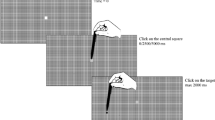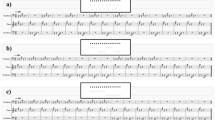Abstract
An experiment was designed to determine the effectiveness of auditory and visual models in the learning of a 2:3 bimanual tapping pattern. Participants were randomly assigned to an auditory model, visual model, auditory + visual model, or a control (visual metronome) group. The task for all groups was to tap a left side force transducer with the left hand and a right side force transducer with the right hand in attempt to produce the desired 2:3 bimanual coordination pattern. The auditory model consisted of a series of tones representing the goal pattern played prior to each practice trial. The visual model consisted of a visual display representing the goal tapping pattern. Visual pacing metronomes were provided to the control group. The right and left side metronomes flashed during the trial in a pattern representing the goal tapping pattern. Subjects in all groups performed 14 practice trials consisting of 15 s each devoted to tapping the goal pattern (total practice time = 3.5 min). A retention test without the aid of the models or metronomes was administered following the practice trials. The results for the model groups indicated extremely effective performance of the bimanual coordination patterns for the auditory, visual, and auditory + visual model conditions with not only the relative, but also the absolute characteristics of the models exhibited during retention testing. Retention performance for the visual metronome condition was less accurate and more variable than the three model conditions. In addition, the auditory + visual model condition resulted in retention performance that was more stable than the auditory model condition.



Similar content being viewed by others
References
Bangert AS, Reuter-Lorenz PA, Walsh CM, Schachter AB, Seidler RD (2010) Bimanual coordination and aging: neurobehavioral implications. Neuropsychologia 48:1165–1170
Bingham GP, Schmidt RC, Zaal FT (1999) Visual perception of the relative phasing of human limb movements. Percept Psychophys 61:246–258
Boyle J, Panzer S, Shea CH (2012) Increasingly complex bimanual multi-frequency coordination patterns are equally easy to perform with on-line relative velocity feedback. Exp Brain Res 216:515–525
Breslin G, Hodges NJ, Williams AM, Curran W, Kremer J (2005) Modeling relative motion to facilitate intra-limb coordination. Hum Mov Sci 24:446–463
Buchanan JJ, Wang C (2012) Overcoming the guidance effect in motor skill learning: feedback all the time can be beneficial. Exp Brain Res 219:305–320
Buchanan JJ, Wright DL (2011) Generalization of action knowledge following observational learning. Acta Psychol (Amst) 136:167–178
Buchanan JJ, Ryu YU, Zihlman K, Wright DL (2008) Observational practice of relative but not absolute motion features in a single-limb multi-joint coordination task. Exp Brain Res 191:157–169
Carroll WR, Bandura A (1982) The role of visual monitoring in observational learning of action patterns: making the unobservable observable. J Mot Behav 14:153–167
deGuzman GC, Kelso JA (1991) Multifrequency behavioral patterns and the phase attractive circle map. Biol Cybern 64:485–495
Deutsch D (1983) The generation of two isochronous sequences in parallel. Percept Psychophys 34:331–337
Elliott MT, Wing AM, Welchman AE (2010) Multisensory cues improve sensorimotor synchronization. Eur J of Neurosci 31:1828–1835
Fujii S, Kudo K, Ohtsuki T, Oda S (2010) Intrinsic constraint of asymmetry acting as a control parameter on rapid, rhythmic bimanual coordination: a study of professional drummers and nondrummers. J Neurophysiol 104:2178–2186
Girard S, Collignon O, Lepore F (2011) Multisensory gain within and across hemispaces in simple and choice reaction time paradigms. Exp Brain Res 214:1–8
Han DW, Shea CH (2008) Auditory model: effects on learning under blocked and random practice schedules. Res Q Exerc Sport 79:476–486
Hodges NJ, Franks IM (2002) Modeling coaching practice: the role of instruction and demonstration. J Sports Sci 20:793–811
Hodges NJ, Chua R, Franks IM (2003) The role of video in facilitating perception and action of a novel coordination movement. J Mot Behav 35:247–260
Hu X, Newell KM (2011) Visual information gain and task asymmetry interact in bimanual force coordination and control. Exp Brain Res 212:497–504
Jancke L, Loose R, Lutz K, Specht K, Shah NJ (2000) Cortical activations during paced finger-tapping applying visual and auditory pacing stimuli. Cogn Brain Res 10:51–66
Jin X, Uygur M, Getchell N, Hall SJ, Jaric S (2011) The effects of instruction and hand dominance on grip-to-load force coordination in manipulation tasks. Neurosci Lett 504:330–335
Kovacs AJ, Shea CH (2009) Performance and learning of a 1:1 bimanual coordination task with 90-degree phase shift. J Sport Exer Psychol 31:S79–S80
Kovacs AJ, Shea CH (2010) Amplitude differences, spatial assimilation, and integrated feedback in bimanual coordination. Exp Brain Res 202:519–525
Kovacs AJ, Shea CH (2011) The learning of 90 degrees continuous relative phase with and without Lissajous feedback: external and internally generated bimanual coordination. Acta Psychol (Amst) 136:311–320
Kovacs AJ, Buchanan JJ, Shea CH (2009a) Using scanning trials to assess intrinsic coordination dynamics. Neurosci Lett 455:162–167
Kovacs AJ, Buchanan JJ, Shea CH (2009b) Bimanual 1:1 with 90 degrees continuous relative phase: difficult or easy! Exp Brain Res 193:129–136
Kovacs AJ, Buchanan JJ, Shea CH (2010a) Perceptual and attentional influences on continuous 2:1 and 3:2 multi-frequency bimanual coordination. J Exp Psychol Hum Percept Perform 36:936–954
Kovacs AJ, Buchanan JJ, Shea CH (2010b) Impossible is nothing: 5:3 and 4:3 multi-frequency bimanual coordination. Exp Brain Res 201:249–259
Lai Q, Shea CH, Bruechert L, Little M (2002) Auditory model enhances relative-timing learning. J Mot Behav 34:299–307
Maslovat D, Hodges NJ, Krigolson OE, Handy TC (2010) Observational practice benefits are limited to perceptual improvements in the acquisition of a novel coordination skill. Exp Brain Res 204:119–130
Mechsner F, Kerzel D, Knoblich G, Prinz W (2001) Perceptual basis of bimanual coordination. Nature 414:69–73
Meesen RL, Wenderoth N, Temprado JJ, Summers JJ, Swinnen SP (2006) The coalition of constraints during coordination of the ipsilateral and heterolateral limbs. Exp Brain Res 174:367–375
Peper CE, Beek PJ (1998) Distinguishing between the effects of frequency and amplitude on interlimb coupling in tapping a 2:3 polyrhythm. Exp Brain Res 118:78–92
Peper CE, Beek PJ, van Wieringen PC (1995a) Frequency-induced phase transitions in bimanual tapping. Biol Cybern 73:301–309
Peper CE, Beek PJ, Vanwieringen PCW (1995b) Multifrequency coordination in bimanual tapping—Asymmetrical coupling and signs of supercriticality. J Exp Psychol Hum Percept Perform 21:1117–1138
Peper CE, Beek PJ, Vanwieringen PCW (1995c) Coupling strength in tapping a 2/3 polyrhythm. Hum Move Sci 14:217–245
Peters M (1989) The relationship between variability of intertap intervals and interval duration. Psychol Res 51:38–42
Roy EA, Clark P, Aigbogun S, Square-Storer PA (1992) Ipsilesional disruptions to reciprocal finger tapping. Arch Clin Neuropsychol 7:213–219
Salmoni AW, Schmidt RA, Walter CB (1984) Knowledge of results and motor learning: a review and critical reappraisal. Psychol Bull 95:355–386
Schmidt RA, Wulf G (1997) Continuous concurrent feedback degrades skill learning: implications for training and simulation. Hum Factors 39:509–525
Schmidt RA, Young DE, Swinnen S, Shapiro DC (1989) Summary knowledge of results for skill acquisition: support for the guidance hypothesis. J Exp Psychol Learn Mem Cogn 15:352–359
Scully DM, Newell KM (1985) Observational-learning and the acquisition of motor skills- Toward a visual-perceptual perspective. J Hum Move Studies 11:169–186
Semjen A, Ivry RB (2001) The coupled oscillator model of between-hand coordination in alternate-hand tapping: a reappraisal. J Exp Psychol Hum Percept Perform 27:251–265
Semjen A, Vos PG (2002) The impact of metrical structure on performance stability in bimanual 1:3 tapping. Psychol Res 66:50–59
Shea CH, Wulf G, Park JH, Gaunt B (2001) Effects of an auditory model on the learning of relative and absolute timing. J Mot Behav 33:127–138
Summers J (2002) Practice and training in bimanual coordination tasks: strategies and constraints. Brain Cogn 48:166–178
Summers JJ, Kennedy TM (1992) Strategies in the production of a 5/3 polyrhythm. Hum Move Sci 11:101–112
Summers JJ, Ford SK, Todd JA (1993a) Practice effects on the coordination of the 2 hands in a bimanual tapping task. Hum Move Sci 12:111–133
Summers JJ, Rosenbaum DA, Burns BD, Ford SK (1993b) Production of polyrhythms. J Exp Psychol Hum Percept Perform 19:416–428
Summers JJ, Todd JA, Kim YH (1993c) The influence of perceptual and motor factors on bimanual coordination in a polyrhythmic tapping task. Psychol Res 55:107–115
Summers JJ, Maeder S, Hiraga CY, Alexander JRM (2008) Coordination dynamics and attentional costs of continuous and discontinuous bimanual circle drawing movements. Hum Move Sci 27:823–837
Suzuki Si (1969) Nurtured by love; a new approach to education. Exposition Press, New York
Swinnen SP (2002) Intermanual coordination: from behavior principles to neural-network interactions. Nature Rev 3:350–361
Swinnen SP, Wenderoth N (2004) Two hands, one brain: cognitive neuroscience of bimanual skill. Trends Cogn Sci 8:18–25
Swinnen SP, Jardin K, Meulenbroek R (1996) Between-limb asynchronies during bimanual coordination: effects of manual dominance and attentional cueing. Neuropsychologia 34:1203–1213
Swinnen SP, Van Langendonk L, Verschueren S, Peeters G, Dom R, De Weerdt W (1997) Interlimb coordination deficits in patients with Parkinson’s disease during the production of two-joint oscillations in the sagittal plane. Mov Disord 12:958–968
Wilson AD, Snapp-Childs W, Coats R, Bingham GP (2010) Learning a coordinated rhythmic movement with task-appropriate coordination feedback. Exp Brain Res 2005:513–520
Wulf G, Shea CH (2010) Motor skill learning and performance: a review of influential factors. Med Educ 44:75–84
Wulf G, McNevin N, Shea CH (2001) The automaticity of complex motor skill learning as a function of attentional focus. Q J Exp Psychol 54:1143–1154
Zanone PG, Kelso JAS (1992) Evolution of behavioral attractors with learning- nonequilibrium phase-transitions. J Exp Psychol Hum Percept Perform 18:403–421
Acknowledgments
This work was supported by a grant from the Huffines Institute, Texas A&M University to D.M. Kennedy.
Author information
Authors and Affiliations
Corresponding author
Rights and permissions
About this article
Cite this article
Kennedy, D.M., Boyle, J.B. & Shea, C.H. The role of auditory and visual models in the production of bimanual tapping patterns. Exp Brain Res 224, 507–518 (2013). https://doi.org/10.1007/s00221-012-3326-y
Received:
Accepted:
Published:
Issue Date:
DOI: https://doi.org/10.1007/s00221-012-3326-y




